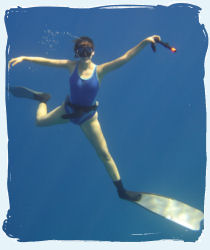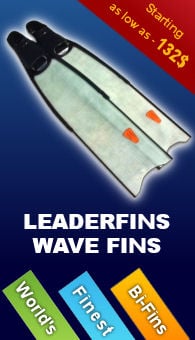Freediving Safety Rules
Below is a list of 20 safety measures to be taken while freediving.
Incompliance with any of the following rules will dramatically increase the chances of an accident occurring in the water.
"God helps those who help themselves" - Benjamin Franklin.
Never ever freedive alone and select your partner
Never dive at the same time as your partner. Your partner should be easily capable of rescuing a diver from the required depth and should be fully trained in rescue techniques and CPR. When performing a safety dive, the objective for the safety diver is to meet the freediver and escort him - face to face through the area of greatest danger - which is between -10 meters and the surface, the depth at which they meet should be relative to the depth that the freediver has dived but not deeper then -15 meters.
Never freedive after a scuba dive
The nitrogen remaining in the tissues after a scuba dive can lead to decompression sickness when micro-bubbles are recompressed and expand upon the rapid ascent during a freedive. Wait at least 12 hours after a scuba dive before you freedive.
Never 'ride' the flexibility of your eardrum
Equalize on descent only. Remember - equalization must come before the feeling of pain in the ears and sinuses. Never continue descending after a failed equalization. A nose clip, where used, should be removed on ascent.
Always be correctly weighted
It is dangerous to be over weighted, This can cause equalization problems on descent and unnecessary expenditure of effort on ascent. A good rule of thumb is to achieve neutral buoyancy at -10 meters.
Before entering the water make a complete dive plan together with your dive buddy and estimate sea conditions
It is essential that every freediver in the group knows exactly what every other freediver will be doing during the course of the outing. This includes warm-ups, deep dives, who is doing safety for whom and when etc.
On returning to the surface - blast clearing the snorkel nearly invariably leads to a shallow water black-out if the freediver has been close to his limits. Retention of the snorkel at depth complicates equalization and when diaphragm contractions begin can lead to the inhalation of water.
Never ever hyperventilate
Hyperventilation is more then 6 deep breaths per minute. This predisposes a freediver to begin the descent in tension with a high pulse rate and decreased CO2 levels. An improper balance of O2 and CO2 can prolong the "easy phase" of the breath hold at the expense of the "struggle phase" and could lead to a shallow water black-out. Proper ventilation has the objective of maximizing the saturation of O2 and minimizing the pulse rate - this is achieved by slow, deep strong ventilation, relaxation and concentration, and this not overdone.
Never dive without adequate rigging and flags
The 'safety' dive line indicates a corridor along which a safety diver can anticipate the return of a diver from depth. Where a buoy and not a boat is being used to suspend the line, it should be orange or red to be easily visible to surface traffic and large enough so it wont be pulled under the surface even by two divers ascending together. Its purpose is to support the dive line and give the freediver on the surface a restful place to prepare his dive. The safety line should be at least 10mm thick to allow for a good grip, preferably white in color. A diver who loses a fin or has a leg cramp can pull himself to the surface using the safety line.
Preserve the correct interval between deep dives. Be aware of the danger of
 multiple deep dives
multiple deep divesNot less then 5 minutes between deep dives. The purpose of this is to allow gas balances to return to normal. Multiple deep dives can severely stress the system and the build up of lactic acid could be dangerous on subsequent dives. Never do more then one or 2 deep dives (the muscles produce lactic acid during activity when denied oxygen).
Never exhale underwater or forcefully exhale on surfacing
Exhalation on descent can cause early problems with equalization. On ascent it causes loss of buoyancy and hence more effort on the ascent which can lead to a shallow water black-out. With any dramatic fall in the pressure in the lungs the remaining reserve of oxygen in the blood will go to the lung and not the brain hence causing shallow water black-out. Any diaphragmatic movement will also act as an instigator for the breathing mechanism.
Avoid too rapid a turn around
Too dramatic a turn around at the end of the descent can lead to a deep water blackout. This is particularly true of very deep dives where blood shift is already a factor.
Never look down on descent or up on ascent
The extension of the neck will cause difficulty in equalization on descent and, on ascent, will affect necessary blood flow to the brain and increase pressure in the area of the baroreceptors in the neck which may cause the to send the wrong message to the central nervous system which may increase pulse rate. Also it is contrary to a hydrodynamic position.
Don't Increase pace on the last part of the ascent
Economy of movement is essential to conserve O2 and keep the pulse rate low. At the turn around point - patience, calm and economy of effort are essential. During the ascent a measured pace must be preserved throughout in spite of lactic acid build up.
Empty lung diving
Empty lung dives are purely an advanced technique which should be approached with EXTREME caution and under the direct supervision of an experienced instructor of these techniques. Sever and possibly permanent damage or death can result if misunderstood. The diver begins the decent with low O2 levels and can blackout without warning at depth where he will be negatively buoyant. If he does not get a laryngospasm at this point the negative pressure in his lungs will siphon in water and a certain drowning will ensue. A partner on full lungs should accompany the diver for the whole of the dive.
Never continue freediving after experiencing a samba or a black-out
Any category of LMC should indicate the end of diving for that person for that day.
Allow sufficient time for physiological adaptation
The body needs time to adapt to new and extreme conditions of prolonged breath-hold and great pressure. Temperature can vastly aggravate or exacerbate the above problems and should not be under estimated. The body is very flexible and forgiving but it is still essential to allow it sufficient time to adapt to new stresses. A headlong rush for greater depth or breath-hold times can either end in severe physical trauma or create a mental 'wall'. Problems like tinitis, pulmonary oedema or other pulmonary barotrauma sinus or even certain types of cardiac problems can result from pushing too hard and too fast.
Avoid negative suggestion
This can lead to stress and hence a danger of a shallow water black-out. The psychology of freediving works on understanding the tremendous power of mental suggestions, and how thinking positively can greatly assist in dive performance.
Never dive when tired or cold
Cold, tiredness, alcohol and drugs all impair judgment and breath hold ability and predispose the freediver to shallow water black-outs. As soon as you feel you are cold - your breath hold ability has already been compromised. Do not underestimate cold - congestion obviously leads to equalization difficulties and the greater danger of 'reversed ear'.
Food and hydration
It is recommended not to freedive within 4 hours of a full meal or two hours after a light snack. The reason for this is that a large volume of blood that could be carrying O2 to the brain is being diverted to the digestive system. Freediving nutrition is a whole issue in itself and should be understood. Dehydration in freedivers is caused by several factors; the mammalian dive reflex (greater production of urine), the expelling of huge quantities of water during ventilation and the chemical exchanges needed for energy production. Water should be there at every dive session and freedivers should be encouraged to drink. Dehydration vastly increases the risk of a shallow water black-out and severely compounds equalization problems.
Know yourself
A freediver should learn to be in touch with himself at all times and to know when to push and when to back off, to know when he is finding excuses and being mentally lazy, and when there is a genuine limitation for that day.
freedive accident how to freedive manual of freediving never dive with cold free diving release mask pressure freedive training freediving freediving equalization freediving training breathholding learn to freedive spearfishing freediving safety frenzel equalization hyperventilation








Excellent tips!
ReplyDeleteThanks alot was helpful
ReplyDeleteThanks alot was helpful
ReplyDelete